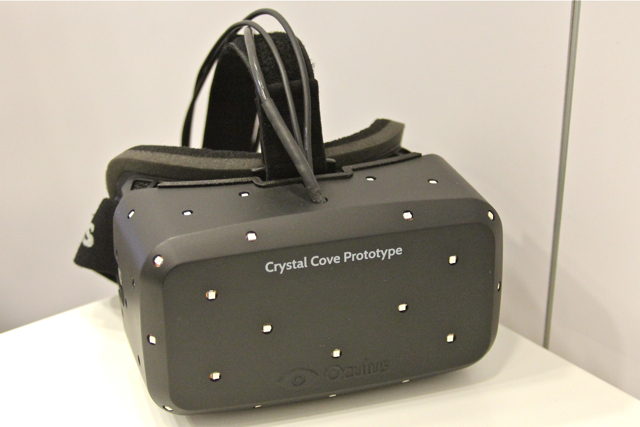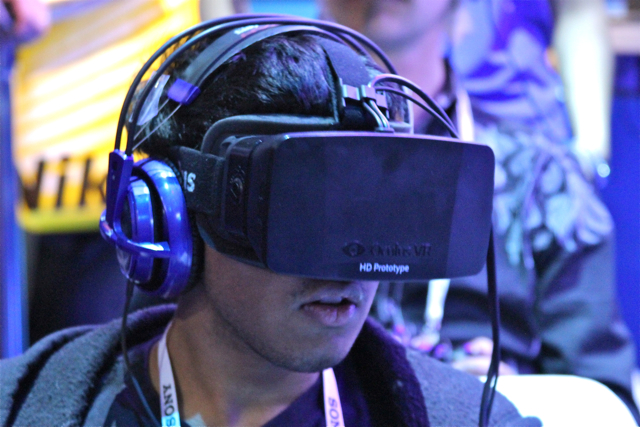Changing the Way We Game: Virtual Reality with Oculus Rift
January 13, 2014
The focal point of the virtual reality renaissance, the Oculus Rift, is edging closer to its consumer release. The company was at the 2014 CES showing off the latest update to its ever-improving 3D head-mounted display with a prototype codenamed Crystal Cove. The new device improves the frame rate and image persistence of its two screens to reduce motion blur. ETC was on-hand to test out the latest VR experience and talk to the company’s young founder, Palmer Luckey.
“We’re out to make something that replicates reality as close as possible,” Luckey said to kick things off. “If the experience is compelling enough there will be a large market for it.”
And when asked whether he was concerned that people would not want to put on anti-social, opaque helmets to play games, the upbeat, 21-year-old’s response was tongue-in-cheek: “You could just as easily say no one is just going to sit in a dark room and play video games by themselves.”
But claims of paradigm altering VR technology have come and gone before. The Rift, therefore, has been approached with a healthy amount of skepticism, and deservedly so, by even hardcore gamers. Having experienced the Crystal Cove first hand, however, I believe that when the final version of the Rift does hit store shelves, the days of playing video games on flat screens are numbered.
The new prototype addressed a number of issues that plagued the original version of the Rift. Many users complained about the queasy feeling or headaches they experienced after using the original Rift for protracted periods of time. Frame rate, image persistence and latency issues were the primary culprits. To fix this, the Oculus team installed dual 1080p AMOLED screens. With refresh rates in the 13 to 35 millisecond range, users can safely spin their head around and not have the world blur around them.
Crystal Cove also features optical tracking, Luckey explains, allowing for “full six degrees of freedom tracking, not just where you are looking but how you are moving through space. You can lean in or move side to side,” to navigate your environment.
But the specifications and descriptions pale in comparison to the experience of putting it on. During my all-too-short demo of the device, I played CCP’s “EVE: Valkyrie” where I flew a ship through space, spotting enemies by looking outside the cockpit in all directions and targeting them with my eyes.
I am a decent gamer, but I was so overwhelmed by the accuracy of my new virtual environment that I had to be reminded to maneuver the aircraft as well as look around. I turned to thank the executive giving me the demo for the reminder and was surprised, if not jarred, to see nothing but stars and the back of the cockpit. Quite simply, it was the greatest gaming experience I’ve ever had. I was truly disappointed to leave it in the meeting room.
My opinion isn’t unique. The prototype won six different best in show awards, from organizations like IGN, PC Mag and Wired, despite not being released yet. And as good as Crystal Cove is, the Oculus team still have time to make improvements before its consumer release.
Oculus is making the Rift available for more than just gaming. Several industries are interested in VR for training, virtual tours and even manufacturing. And while the path isn’t as clear for its cinematic appeal, Palmer believes, “you can put together compelling emotional experiences,” based on a narrative that would be appealing. USC’s Nonny de la Pena has been at the forefront of this frontier, experimenting with VR as a tool for immersive journalism.
Despite all their lofty goals, Oculus is striving to keep the price low. For example, the original version of the Rift prototype is available in development kit form for $300. And while Luckey couldn’t reveal any specifics about pricing or a release date, he did say 2014 will be a big year for VR and that Oculus is, “ramping things up very fast.”



No Comments Yet
You can be the first to comment!
Leave a comment
You must be logged in to post a comment.